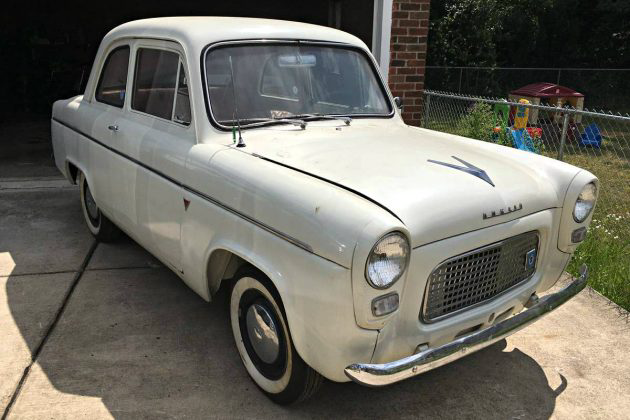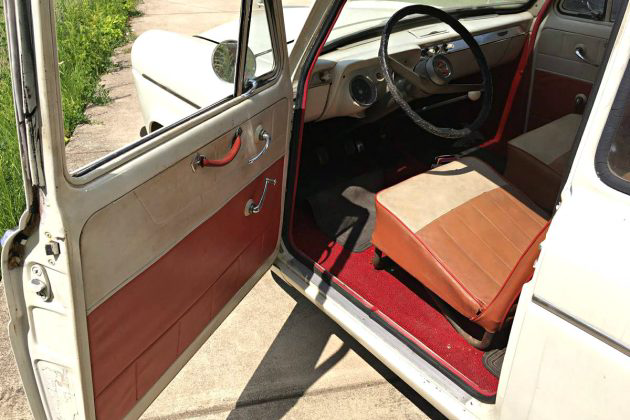Clean English Tin: 1959 Ford Anglia 100E
British and pint sized, the Ford Anglia is a well-recognized car in Europe, as well as in America. More commonly seen now a ’days with V8 swaps, and big tires, it isn’t all that often that a clean one pops up for sale. Needing some minor work, this Brit could be back on the road in nothing flat! Offered for $4,000 this solid little Anglia would be an enjoyable small classic. Check it out here on craigslist out of Dearborn, Michigan. Thanks to reader Pat L. for this clean little submission!
Although having laid dormant for a few months, the engine does turn over and run. The engine bay is very tidy, and shows little in the way of patina. There is a minor amount of surface rust on the exhaust manifold, and the cylinder head. Hardly worth mentioning really. The only major mechanical concern is that the brakes need some assembly, and bleeding according to the seller. Beyond that, this car seems well sorted and in what I assume to be good health.
Looking inside, you can’t help but feel pleasantly amazed at the interiors condition. With red, cream, and saddle tan, this interior has a lovely appearance, and there is no immediate damage to be seen other that some dirt on the upper portion of the door panels, and some dirt on the carpet. It is unclear as to whether this Ford has been completely restored in its lifetime, or if it was a nice driver that received some paint in the 1970s.
A little dirty, this $4,000 Anglia is extremely solid with no evidence of rot, or major damage. The paint is a bit dirty, and the seller mentions that with a bit of cleaning the car should shine wonderfully. There is still a luster to the paint, so I can certainly believe it would clean up nicely. The trim, rubber seals, and glass, all look nice and the more you look, the harder it seems to find flaws with this Ford. The only real concerns I can find is that there is a rusty spot on one of the under body supports, and also the exhaust needs some rigging to be street ready as well. $4,000 can be spent many ways, but this Little Ford seems like a reasonable way to use that type of cash. Would you venture into this Anglia project?
Auctions Ending Soon
 1969 Ford MustangBid Now11 hours$1,050
1969 Ford MustangBid Now11 hours$1,050
 1965 Ford Falcon Station WagonBid Now3 days$2,300
1965 Ford Falcon Station WagonBid Now3 days$2,300
 2002 Jaguar XK8 ConvertibleBid Now4 days$4,250
2002 Jaguar XK8 ConvertibleBid Now4 days$4,250
 1979 Chevrolet Camaro Z/28Bid Now5 days$4,500
1979 Chevrolet Camaro Z/28Bid Now5 days$4,500
 1960 Dodge D300Bid Now5 days$300
1960 Dodge D300Bid Now5 days$300





Comments
The most interesting thing about these are the road racing cars the engines powered.
And the earlier generation Anglia’s were usually used for racing too – but with the engines thrown away and big V8’s installed for the classic Gassers!
Thanks Brian. THIS is what the old man came home with once. It was the 1st foreign car I can remember, and as a kid, just seemed so anemic and tinny compared to the old man’s Oldsmobiles. Not sure how he got it, as these were nonexistent in the midwest, but it was British, so that was ok by him.( Dubja Dubja 2, you know) While it’s cute, remember what 28 hp ( or whatever) is like. 40 mph will seem like the world is coming apart, not to mention the traffic jam behind you. Cool find.
With 36 bhp, this would be bad on an interstate.
Howard, they weren’t entirely nonexistent in the Midwest–we had one back in the late ’50s or early ’60s, in bright blue! I don’t know why my father bought one, except that he knew nothing about cars, and didn’t care to learn. He always had Ramblers, but I guess he wanted a cheap commuter car. I think it was a disappointment, given frequent breakdowns. Some time after he sold it, the police called him because it had been abandoned by the side of the road. I guess the next owner was just cutting losses.
I loved it, by the way. Then again, I was a kid. And there’s a classic Mini in my garage, so I’m probably not the best judge of cars, LOL.
I was brought up with side-valve Fords in Ireland. They were known for their simplicity and reliability and the earlier E93A and later 100E engines as fitted to this car were the staple diet of UK and Irish club racing. You could get over 60 mph out of one. By the way the mechanical fuel pump has been bypassed but the car looks in great original shape. An amazing survivor !
Bypassing the mechanical pump is a Good Thing for several reasons. In the case of the Squire I had for a year or two, the pump kept vapor-locking, even in subzero weather. That turned out to be due to the manifold-to-exhaust-pipe connection, immediately adjacent to the pump, having a leaky gasket!
That said, a good low-pressure electric pump situated back by the fuel tank is cheap insurance for any car against vapor lock, especially in hot climates.
Saw one or two of these in Merrye Olde whilst posted there in the late 70’s. This one was fortunate to have crossed the pond to our Midwest where it was not exposed to British snow and ice control processes. Except in the way north, the Brits don’t plough, they salt and in great quantities. My 67 mini countryman was one or two MOTs away from failure due to rust and the knacker’s yards were chock-a-block full of floorless vehicles that were otherwise serviceable. Rust-proofing with Wax-Oyl was an option used by those who could afford it and I believe it had to be repeated annually. I honestly think that bullet-proof and rust proof cars would have brought on an even earlier demise of the British motor manufacturing industry as the steady stream of replacement vehicles would not have been needed. The productivity enhancement schemes pushed by the unions of the sixties and seventies, where the more you make the more you got paid, resulted in fields of over produced cars sitting on disused WW II airdromes unsold for years. Of course, after a few years, they were brought in for a re-spray (putting more blokes to work) and after a few more the vermin would have chewed up the wiring and upholstery providing work for yet another follow-on industry. The same sort of thing happened to Ford when they had their Escort “world car”. Ford made several thousand left hand drive editions for the continent. But because Britain never became a full partner in the EEC (European Economic Community), the “continent” refused to import them. Ran into an English lorry driver in Orlando, FL on holiday, whose job entailed hauling these unsalable Fords to my old station at Upper Heyford and putting them into storage in the hardened aircraft shelters we had built for our F-111s. That was mid to late Eighties and I often wonder what eventually happened to them. The British auto industry imploded, kind of like the proverbial foo bird that flies in an ever decreasing spiral until it eventually flies up its own rear end and disappears. We here in the Colonies are fortunate to have the opportunity to rescue and preserve the examples that made it to our shores I have five, including a kit car (Jamie!) built on a British chassis, so I’m doing my part. Someone please save this li’l fella as he is.
I have advertised this on ford100e.com for you I hope it help sell the car
All the best Graham
http://www.ford100e.org/
What’s with the bellhousing and clutch release arm?
English Fords were fairly commonplace in 1960s South Florida. Even the local Servicemaster franchisee had a fleet of English Ford Thames vans. The later “Harry Potter” Anglias were also fairly popular (PUN!), as were the Cortinas in 2-door, 4-door, and wagon variations. Fewer in number, there were some mid-sized Consuls and Zephyrs around, too. My parents almost bought a late 50s Consul convertible as a second car (to free up our ’63 Mercury Colony Park for use by my stepdad, who drove all over the state of Florida as a salesman), but went with a ’60 Simca P60 Aronde instead (surprisingly, not a bad choice). My older brother’s best friend had a mid-50s Ford Prefect, whose design hadn’t changed markedly since the late 1930s. He used to demonstrate how it could be hand-cranked to start (with Lucas electrics, it probably needed to be cranked once in awhile). The last European Fords were British and German in the guise of the Capri, sold at Lincoln-Mercury dealers, which, if maintained properly, were pretty decent cars.
These cars might have been even more popular had the dealers not “encouraged” their sales staff to “upsell” these captive imports to American Fords. Same could be said for Buick dealers and the Opel, and the Pontiac dealers for the pre-rusted Vauxhall, not to mention Chrysler-Plymouth and Dodge dealers actively upselling customers away from the Rootes (Singer, Sunbeam, Humber, Hillman, etc.) and Simca products. Now maybe in the case of the Rootes products, that wasn’t entirely a bad idea!
You know this car is not a 100e. It is a 101e Deluxe. I have a 58 101e Deluxe myself. My car 99% rust free. It has been off the road since 78. The deluxe had a radio with chrome down the side and around the front and back window. This is one made to export to the U.S. as it is a left hand drive. I had 2 as my first car back in 74, a 58 and a 59. The 58 ran so I striped the 59 for parts. Paid $150.00 for both. The one I have now I paid $1800.00. Never understood way the door hinges were made of aluminum.
Looking for an english ford or Morris minor
I always see ads but nowhere to contact anyone